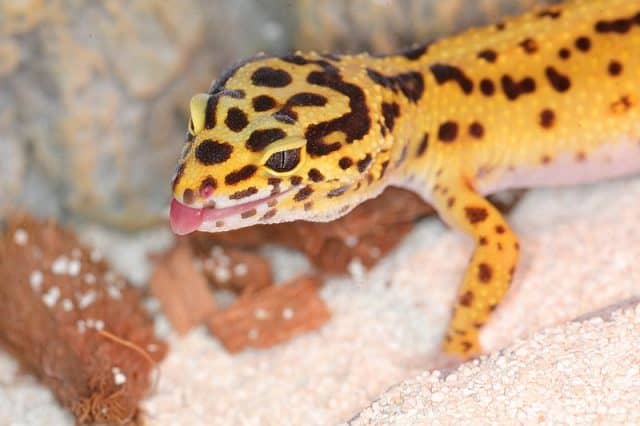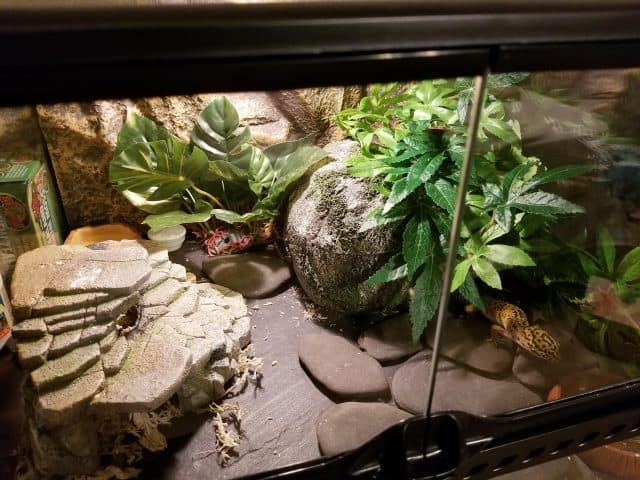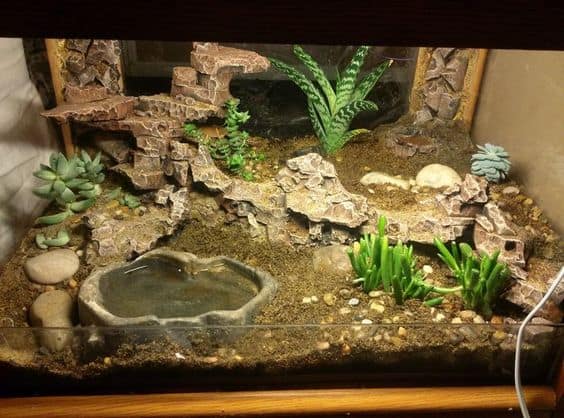Leopard Geckos can make excellent companions for people that love reptiles, including children. They’re docile creatures and can be easily tamed. But despite being some of the easiest reptiles to maintain, they can die within a year or two just because the cage conditions are not appropriate.

A Leo’s tank should be around 10 gallons if it stays alone, 15 gallons if it’s a pair, and at least 20 gallons if it’s a group of 3 or 4 Leos. They can live up to 20 years in captivity and the substrate you use makes all the difference.
In this article, we’ll talk about what types of substrates to use and what to avoid when making a vivarium for a Leopard Gecko.
Types of substrates for Leopard Gecko Tanks
Geckos are extremely popular pets all over the world, especially Leopard Geckos. This means you will be able to find everything you need while also remaining on a budget if you need to. There are also both artificial and natural options that can keep your gecko healthy and happy.
While artificial substrate can last longer, natural options can make the gecko feel like in its natural habitat. It’s great if you can make it a bioactive enclosure, but that’s more difficult. This can lead to a much happier gecko that’s friendlier and more interesting to observe. Food, temperature, humidity, and substrate are the 4 extremely important things you need to pay attention to when having a gecko.
A bad substrate can immediately lead to illness and sometimes even death. Sadly, there are also cases where you don’t even know anything is wrong and the gecko feels fine until it’s suddenly too late to do anything.
Leopard Geckos are desert reptiles but definitely not Sahara-like sandy deserts. It’s shocking how many new gecko owners don’t bother to look up what the natural habitat of their Leo looks like. These lizards do live in rocky deserts around Asia.
The reason why sand is so bad is that small Leos can ingest it. At first, everything seems fine and they may continue to lead a happy life for a whole more year. But when the sand starts building up, that’s when the problems start as well.
Sand can’t be digested by Leos and this leads to a condition named impaction. This is a life-threatening condition that can kill your Leopard Gecko pretty fast. And as mentioned before, you won’t be able to tell that something is wrong until it’s too late.
Reptile Carpet
It’s very important that the substrate you use doesn’t cut your geckos tiny and fragile feet and can’t be eaten by the Leo. But if it does end up eating it, you have to make sure it’s a material it can digest without causing any issues. And this is where reptile carpets come in.
Reptile carpets also referred to as repti-carpets, are one of the best choices of substrate for Leos. You can opt for reptile carpets made of artificial material or of natural material. There are lots of options available and almost all of them are safe. There are also sand carpets that you need to avoid.
The biggest advantages of using a reptile carpet are that it’s not loose, edible, messy, or problematic in any way. It comes in big rolls and you can easily use a pair of scissors to cut it into size. It’s also not very expensive and can enhance your Leo’s life quality tremendously.
Since Leos are also known to poop a lot, especially if you have more than one in the same tank, you’ll want a substrate that’s good and durable. Reptile carpets offer everything your Leo needs without the risk of ingestion.
When it comes to cleaning, most reptile carpets can be cleaned within a few minutes. But you should keep in mind that you’ll have to wash them as soon as they’re soiled. Otherwise, they can get permanently stained.
Zilla Reptile Terrarium Bedding Substrate Liner
The Zilla Reptile Terrarium Bedding Substrate Liner is high-quality and easily one of the easiest-to-clean on the market. You can spot-clean it every day without any issues, take it out after a few weeks, turn it on the clean side, and place it into the tank again. This might only work if you have only one Leopard Geckos.
When it comes to proper cleaning, it’s best to invest in two rolls at the same time. This will allow you to take the dirty one out, hose it properly, then let it take its time to dry very well. Within this time, you can use the other reptile carpet.
Its dimensions are 11.75in x 35.5in and it’s incredibly affordable. This gives you the opportunity to continuously maintain a clean environment for your gecko. It’s low-maintenance and all you have to do when setting in the tank is roll it out and cut to it size.
Thanks to its Leopard Gecko-safe design, you won’t have to worry about ingesting it and creating any health issues. It’s even better for juvenile reptiles. It’s highly absorbent, non-abrasive, and will not irritate your reptile while sleeping.
This reptile carpet is also treated with a biodegradable enzyme that reduces odors and is easy to clean using nothing but cold tap water. It’s made in the U.S.A. and it offers unmatched quality.
Paper Towels
If you’re not interested in owning the coolest-looking vivarium and you’re good with any substrate, the best choice you can possibly opt for is paper towels. This is excellent for people on a tight budget as well. But unfortunately, they definitely don’t look nice.
However, there are lots and lots of positive reasons you can use paper towels that will make you forget about how ugly they can be. But be careful to only use paper towels that have not been bleached and that don’t contain any ink. Plain white is all you can use.
This substrate option is even better for younger geckos. They’re easy to replace and clean, lowering the risk of illness considerably. And more importantly, they’re white. This means you will immediately be able to see unwanted mites, mold, etc.
You also won’t have to worry about inhaling any bad particles or ingestion with this hygienic substrate. Paper towels are durable but also very soft, which is very important for the soft bellies of Leopard Geckos. Since they’re so affordable and work so great, they’re excellent for reptile owners who have multiple enclosures and would like to save money.
Stone Slates
If you do care a lot about how the vivarium looks, you do have an option that’s safe for your Leo and looks extremely well. Stone Slates are an excellent option and if you’re decorating its enclosure properly, it can look like a Leopard Gecko’s natural environment.

Stone Slates gives you the chance of creating a small doorway to another world right in your home, especially if you own a bigger tank with more Leos. They’re visually the best choice on the market, much better than hollow three ornaments and similar lizard cage decorations.
But a great look is not all this substrate can offer. You also won’t have to worry about the Leo ingesting any bad particles as Stone Slates are big pieces of rock that can last an extremely long time. It can help you safely recreate a Leopard Geckos natural habitat without emptying your pocket.
Besides offering a natural environment, Stone Slates retain heat very well, which is important for a heat-loving lizard. This is also one of the best choices you can possibly go for if you’re trying to keep maintenance at a minimum.
Carolina Custom Cages Natural Habitat Rocks, Deep Maroon
The Carolina Custom Cages Natural Habitat Rocks, Deep Maroon are excellent for vivariums that keep various reptiles, amphibians, and turtles. Their main job is to serve as basking rock as they’re great heat conductors and high-heat-loving lizards would appreciate one.
Since Leopard geckos are not very big, a large rock will be more than enough for your little friend. But it will also be great to get more than one and recreate the rocky natural habitat of a Leo. And if you have more than one Leopard Gecko, you can use these to create caves.
These are carefully hand-selected rocks by reptile experts and enthusiasts to ensure they’re safe for a reptile. This means the rocks have at least one side that is flat and no sharp edges that could hut your Leo. The general dimensions are 7-1/4in x 12-5/8in.
Another great advantage is that these rocks have enough natural porosity that prevents the rocks from getting too hot when they keep accumulating heat. You should be prepared to receive slightly different rocks as they are real rocks and not cast resign or coated Styrofoam.
These rocks will weigh anywhere between 5 and 8-9 pounds. They’re very easy to clean and can be used as both substrate and basking rocks.
Coconut Fiber
Now let’s also talk about a substrate that is not necessarily the best, but it’s important to know as much as possible about it so you can make an informed decision. This is the Coconut Fiber substrate. The reason why it’s not the best is that it can be ingested, although it doesn’t cause impaction. However, it’s often considered an unnecessary risk.
Another reason why Coconut Fiber substrate is included in this list is that it can solve a lot of problems for reptile owners that have problems with maintaining a low humidity level. Leopard Geckos can get very sick from high levels of humidity and this substrate can help you maintain a dryer enclosure.
Other advantage is that it’s very affordable, has incredible antimicrobial properties, and it looks very natural. You can also use it if you have problems with preventing mold, rotting, bad odors, etc. Again, this is not the best on the market, but it’s still a good choice, especially if you have any of the issues mentioned above.
Your Leopard Gecko will love digging in it and you won’t have to use two different substrates for wet and dry areas. You can simply wet the Coconut Fiber substrate and use it where the gecko needs a wet substrate and keep it dry for the rest of the habitat.
Reptile Prime Coconut Fiber Bedding Substrate
The Reptile Prime Coconut Fiber Bedding Substrate is an excellent choice for terrarium set-up if you want to ensure the humidity level doesn’t rise. It can be used in enclosures for reptiles, amphibians, and invertebrates.
Since it can be easily used both dry and damp, you can use it for any of your tropical species or desert-dwelling creatures. It’s highly absorbent and can deal very well with bad odors. This will ensure neither you nor the gecko is bothered by the bad smell.
Its biological design makes it highly environmentally-friendly as well. It has a high capacity to absorb and break down odor and feces. You can also use it as a standalone substrate for plant growth in plant terrariums.
This product is made from the husks of coconuts and can be easily composted or recycled into potted plants. More importantly, it’s dust-free and great for your Leopard Gecko. It’s made in the U.S.A. as well.
Your Leopard Gecko has sensitive feet and belly so this bedding can keep them safe from any cuts. The cleaning process will be pretty straightforward. The only downside is that you will have to deal with a lot of dirt when you’re disinfecting the tank and changing the substrate.
Excavator Clay Substrate
If you love getting creative and you have a lot of time and money to spend on making the vivarium, you might want to consider Excavator Clay substrate. This is one of the newest types of substrates on the market and it makes raves among creative reptile owners.
You should keep in mind that it can be pretty expensive but it comes with its own unique benefits. This allows you to create the exact home you want for your geckos. Whatever you put your mind to, you can easily achieve.
When you get this clay sufficiently moist, you can start using it like any other modeling clay. This gives you the possibility to create anything, wait a few hours for it to dry, and then you can introduce your gecko to its new place. After it gets completely dried, the clay remains in place.
You can start making caves, burrows, basking spots, and anything that comes to mind for your little geckos. If you’re the type of reptile owner that loves showing off all types of fancy vivariums, this substrate can help you take your craft to a whole new level.
It doesn’t have any bad side effects and your gecko can use it happily for years. It’s also easy to clean and it has great odor-masking properties, allowing you to change the clay from the bottom of the cage less frequently.
Zoo Med Excavator Cavern Kit
The Zoo Med Excavator Cavern Kit is designed to include everything you need to create a homier habitat for your desert and burrowing reptiles. This makes it great for Leopard Geckos. It’s made in the U.S.A. and the bag of clay weighs 12lbs. This is enough for making a fancy home for a Leo.

The kit includes a 12lbs excavator clay substrate, 7in tunnel tube, 5in round balloons (2), 9in round balloons (2), balloon attachment assembly, 10in shovel, excavator mixing bag, and a full user’s manual. You will receive everything necessary to make caverns, tunnels, and shelters.
When using this clay kit to make a better home for your reptiles, your imagination is the limit. It works great for various reptiles and once it’s dried, it remains like that for a very long time. The drying time is between 4 to 5 days so make sure you get this kit plenty of time ahead.
It’s recommended to keep the vivarium with the modeled clay in a ventilated room to allow it to dry thoroughly. Unfortunately, this clay is not for beginners and you might be left disappointed if you can’t figure out how to mix it properly.
The value of the kit is acceptable, especially since it contains everything you need to create your Leo’s dream home.
FAQ – Frequently Asked Questions
Can I use soil for my leopard gecko?
Using any type of loose substrate is very controversial as you don’t have to put your Leopard Gecko through such risks. Accidental ingestion can cause intestinal blockage as well.
How often do you replace leopard gecko substrate?
The general rule of thumb is changing the substrate every 3 to 4 months. But it obviously all depends on what type of substrate you use.